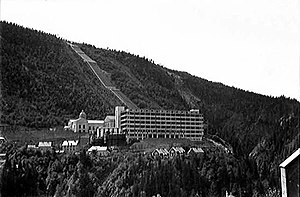Operation Freshman
| Operation Freshman | |
|---|---|
| Part of the Second World War | |
 The Vemork Hydroelectric Plant photographed in 1935. |
|
| Type | Sabotage |
| Location |
Telemark, Norway Coordinates: 59°52′16″N 8°29′29″E / 59.87111°N 8.49139°E |
| Planned by |
Combined Operations Headquarters SOE |
| Objective | Destroy German heavy water production at Vemork |
| Date | 19 November 1942 |
| Executed by | 34 glider borne commandos |
| Outcome | Failure |
| Casualties | 41 killed, 2 Horsa gliders and 1 Halifax bomber lost |
Operation Freshman was the codename given to a British airborne operation conducted in November 1942 during World War II. It was the first British airborne operation conducted using gliders, and its target was the Vemork Norsk Hydro chemical plant in Telemark, Norway which produced heavy water for Nazi Germany. By 1942, the German nuclear weapons programme had come close to being able to develop a nuclear reactor, but in order for the reactor to function it would require a great deal of heavy water. The source of the heavy water was the Norsk Hydro plant, which had been occupied in 1940; when the British government learned of the German nuclear developments, it was decided that a raid would be launched to destroy the plant and deny the Germans the heavy water required to develop a nuclear weapon. Several tactics were discussed and discarded as impractical, and it was finally decided that a small airborne force composed of sappers from the Royal Engineer units attached to 1st Airborne Division would land by glider a short distance from the plant, demolish it with explosives and then escape over the Norwegian border into Sweden.
After a period of extensive training, the airborne force took off in two aircraft–glider combinations on the night of 19 November 1942. Both managed to reach the Norwegian coast, but neither was able to reach their objective. The first pair suffered from navigational difficulties and severe weather, which resulted in the tow rope snapping and the first glider crash–landing, with its towing aircraft returning to base; three airborne troops were killed outright, with the survivors captured shortly after the crash. The second pair fared even worse, with both aircraft and glider crashing into a mountain for unknown reasons; the aircrew and some airborne troops were killed outright, and those who survived were taken prisoner. None survived for very long, being executed as a result of Adolf Hitler's Commando Order, which stated all Commando personnel were to be immediately executed upon capture. At the end of the war, Wehrmacht personnel were tried and condemned to death for their part in the executions.
...
Wikipedia
